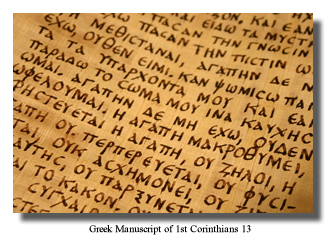The Transmission and Identification of the Inerrant Text of Scripture
I was very blessed to have grown up around such men as Cornelius Van Til, John H. Skilton, Theophilus Herter and Milton Fisher. The Lord shaped my thinking on what Scripture is, and how God preserved it, from my earliest days. After I was converted, I began to diligently study the doctrine of inerrancy, the canon, and the apocryphal books. I had many questions, and was determined to learn everything I could about the original autographa, the transmission of Scripture, the canonicity of Scripture, the internal witness of Scripture and the philosophy of history as it related to the preservation of the word of God. In God’s providence I was led to the following articles and books that served to solidify and further shape by beliefs on this subject. Many of the great questions that the student of Scripture must wrestle with rest on the doctrine of the inerrancy of Scripture. But there are many questions that arise with regard to inerrancy itself. Such questions as, “Where are the inerrant texts to be found?” “Are our English translations inerrant?” “Did God preserve His word to be free from error in the Greek and Hebrew manuscripts that we have today?” “Was B.B. Warfield correct when he said that the only inerrant documents were the autographa (i.e. those books/letters that were directly penned by the authors of Scripture)?” These, and other questions have been taken up in the following works:
William Henry Green, General Introduction to the Old Testament: The Canon (Though somewhat dates, this is one of the most helpful books written on the canon. It radically shaped the way I viewed the attestation of Scripture.)
John H. Skilton, “The Transmission of the Hebrew Text” (Perhaps the single most helpful article written on the transmission of the OT Scripture, and the variants present in the Masoretic text)
John Murray, “The Attestation of Scripture” (From the same volume as the previous article. Murray shows how the recognition of Scripture depends on its own internal witness and authority. A very helpful article.)
Laird Harris Inspiration and Canonicity of the Scriptures (As comprehensive as William Henry Green’s work, with more recent developments in critical studies.)
The Infallible Word (A Westminster Seminary Symposium that includes the Skilton and Murray articles mentioned above. There are many other helpful chapters in this compilation volume.)
Theodore Letis B.B. Warfield and the Reformation Doctrine of the Preservation of the Original Text (Letis has some extreme views elsewhere, but this is a very helpful article. B.B. Warfield had argued that errancy only existed in the original autographa. Letis suggests that our Puritan forefathers believed inerrancy was to be found in the preserved Greek and Hebrew texts. While I do not believe that the Textus Receptus is inerrant, I do follow some of Letis’ argumentation that God preserved the inerrant word in the original languages. While this is not relegated to one particular text, I do believe that it is to be found in the Greek and Hebrew. At the very least, Letis’ article is thought provoking.)
UPDATED RECOMMENDATIONS
Michael J. Kruger Canon Revisted (Probably the best work on the canon written in the 21st Century).
Charles E. Hill and Michael J. Kruger ed. The Early Text of the New Testament (A tremendously scholarly compilation volume that deals with a multitude of pertinent issues on NT textual matters. You can listen to an interview we did with Dr. Kruger regarding this book on Christ the Center.)




I really like that article by Letis. Haven’t checked them all yet. The understanding of the preservation of the text and which methods of textual criticism are to be preferred is, I think, a lot more complex than most of us really grasp. We are too quick to reject a passage like the Ascension of Christ, or accept a marginal note which reads “some Mss say” or “Better MSS include” without really understanding all the presuppositions or actual facts behind the assertions.